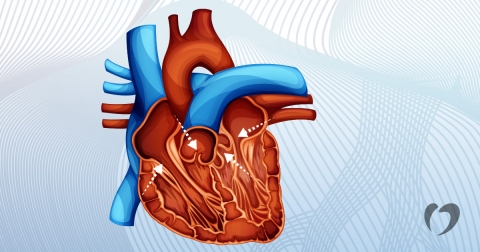An overview of valve disease

There are four valves in the heart: the tricuspid, pulmonary, mitral, and aortic valves. As blood exits each of the four chambers of the heart, the valves open to allow blood through and then close to prevent blood from flowing backward.
When one or more of the valves do not function properly, one of several types of heart valve disease can occur:
- Regurgitation occurs if the valve doesn’t close properly and some blood flows backward into the chambers.
- Stenosis occurs when the valve begins to narrow, thicken, or stiffen and doesn’t allow enough blood to flow through.
- Atresia occurs when the valves don’t open properly for blood to flow through.
Valve disease can be genetic or can develop over time, and some cases may not have an identifiable cause. There are two basic types of genetic valve disease.
- Congenital valve disease typically occurs when the aortic or pulmonary valve is the wrong size or is malformed in a way that impacts the function.
- Bicuspid aortic valve disease is a congenital valve disease in which the aortic valve has only two leaflets instead of three, which results in the valve being unable to open or close properly or leaking when closed.
Common causes of acquired valve disease include:
- Rheumatic fever that occurs from an untreated bacterial infection, such as strep throat. While the infection often occurs in children, the associated heart problems may not occur for many years. The heart valve becomes inflamed and the leaflets of the valves begin to stick together or change shape, which can lead to mitral regurgitation.
- Endocarditis is also related to germs and bacteria that enter the blood stream and may result in holes or scarring that can lead to leaky valves. Bacteria that causes endocarditis can enter the bloodstream through dental procedures, surgery, IV drug use, or severe infections. People with existing valve disease are also at increased risk for developing endocarditis.
- Other conditions, such as coronary artery disease, heart attack, cardiomyopathy, hypertension, syphilis, and less commonly, some drugs and radiation.
Symptoms may include shortness of breath, dizziness, chest discomfort, palpitations (racing heartbeat), rapid weight gain, or swelling of the ankles, feet, or abdomen. To diagnose valve disease, your Oklahoma Heart Hospital physician will discuss your symptoms, listen to your heart, and order diagnostic tests, which may include an echocardiogram (ultrasound of the heart), cardiac catheterization (angiogram), or an MRI.
Treatment focuses on preventing further valve disease, reducing symptoms, and repairing or replacing valves. Treatment plans will vary based on the type and location of valve disease, but may include medications or surgery to repair or replace a valve. Individuals with valve disease should also take precautions to reduce their risk of endocarditis, such as getting quick treatment for infections, taking care of their teeth and gums, and taking antibiotics prior to any medical procedure that may result in bleeding.
If you experience symptoms of valve disease, contact the Oklahoma Heart Hospital today to schedule an appointment with one of our physicians.




